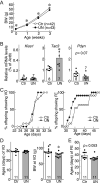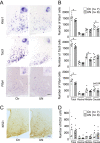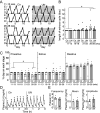Long-term effects of prenatal undernutrition on female rat hypothalamic KNDy neurons
- PMID: 36408965
- PMCID: PMC9782422
- DOI: 10.1530/EC-22-0307
Long-term effects of prenatal undernutrition on female rat hypothalamic KNDy neurons
Abstract
The nutritional environment during development periods induces metabolic programming, leading to metabolic disorders and detrimental influences on human reproductive health. This study aimed to determine the long-term adverse effect of intrauterine malnutrition on the reproductive center kisspeptin-neurokinin B-dynorphin A (KNDy) neurons in the hypothalamic arcuate nucleus (ARC) of female offspring. Twelve pregnant rats were divided into ad-lib-fed (control, n = 6) and 50% undernutrition (UN, n = 6) groups. The UN group was restricted to 50% daily food intake of the control dams from gestation day 9 until term delivery. Differences between the two groups in terms of various maternal parameters, including body weight (BW), pregnancy duration, and litter size, as well as birth weight, puberty onset, estrous cyclicity, pulsatile luteinizing hormone (LH) secretion, and hypothalamic gene expression of offspring, were determined. Female offspring of UN dams exhibited low BW from birth to 3 weeks, whereas UN offspring showed signs of precocious puberty; hypothalamic Tac3 (a neurokinin B gene) expression was increased in prepubertal UN offspring, and the BW at the virginal opening was lower in UN offspring than that in the control group. Interestingly, the UN offspring showed significant decreases in the number of KNDy gene-expressing cells after 29 weeks of age, but the number of ARC kisspeptin-immunoreactive cells, pulsatile LH secretions, and estrous cyclicity were comparable between the groups. In conclusion, intrauterine undernutrition induced various changes in KNDy gene expression depending on the life stage. Thus, intrauterine undernutrition affected hypothalamic developmental programming in female rats.
Keywords: fetal programing; kisspeptin; low birth weight; prenatal undernutrition.
Conflict of interest statement
The authors declare no conflict of interest.
Figures





Similar articles
-
Malnutrition alters protein expression of KNDy neuropeptides in the arcuate nucleus of mature ewes.Front Physiol. 2024 Jun 7;15:1372944. doi: 10.3389/fphys.2024.1372944. eCollection 2024. Front Physiol. 2024. PMID: 38911326 Free PMC article.
-
Effects of intrauterine undernutrition on hypothalamic Kiss1 expression and the timing of puberty in female rats.J Physiol. 2010 Mar 1;588(Pt 5):821-9. doi: 10.1113/jphysiol.2009.183558. Epub 2010 Jan 18. J Physiol. 2010. PMID: 20083512 Free PMC article.
-
The impact of undernutrition on KNDy (kisspeptin/neurokinin B/dynorphin) neurons in female lambs.J Neuroendocrinol. 2022 Jun;34(6):e13135. doi: 10.1111/jne.13135. Epub 2022 May 17. J Neuroendocrinol. 2022. PMID: 35579068 Free PMC article.
-
Nutritional control of puberty in the bovine female: prenatal and early postnatal regulation of the neuroendocrine system.Domest Anim Endocrinol. 2020 Oct;73:106434. doi: 10.1016/j.domaniend.2020.106434. Epub 2020 Jan 10. Domest Anim Endocrinol. 2020. PMID: 32115309 Review.
-
Review: Gestational and postnatal nutritional effects on the neuroendocrine control of puberty and subsequent reproductive performance in heifers.Animal. 2023 May;17 Suppl 1:100782. doi: 10.1016/j.animal.2023.100782. Animal. 2023. PMID: 37567667 Review.
Cited by
-
Effects of prenatal stress on reproductive function of male offspring through the KISS1 system.Endocr Connect. 2024 Sep 13;13(10):e240027. doi: 10.1530/EC-24-0027. Print 2024 Oct 1. Endocr Connect. 2024. PMID: 39140811 Free PMC article.
References
LinkOut - more resources
Full Text Sources

